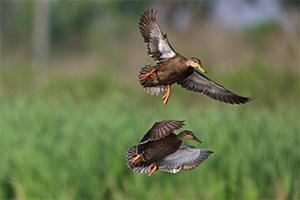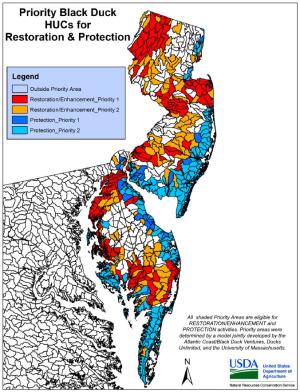American Black Duck
The American black duck (Anas rubripes) is an iconic species of East coast marshes from New York to Virginia. The loss of coastal habitats because of development, pollution and wetland conversion has contributed to the decline of black ducks.

The American black duck (Anas rubripes) is an iconic species of East coast marshes from New York to Virginia. The loss of coastal habitats because of development, pollution and wetland conversion has contributed to the decline of black ducks. Between the 1950s and 1980s, black duck populations declined by more than 50 percent.
The Mid-Atlantic region supports the largest populations of North America’s wintering black ducks, and protecting and restoring habitat in the region is critical to the long-term sustainability of the waterfowl species. To help reverse black duck declines, NRCS is working with private landowners in the Delaware Bay and Chesapeake Bay watersheds to increase available high-quality habitat to support the species’ recovery.
Landowners in Delaware, Maryland, New Jersey and Virginia are helping the black duck by restoring and protecting wetland ecosystems. With the help of NRCS, landowners are making wildlife improvements to working lands and protecting lands not suitable for farming with conservation easements. Through conservation practices, landowners are restoring tidal and floodplain wetlands, as well as managing healthy riparian areas and streams. Conversion of unproductive fields experiencing saltwater intrusion in order to create salt marsh habitat is a particular focus of this effort.

NRCS offers technical and financial assistance to help agricultural producers voluntarily restore and protect wetland habitat on private lands. This assistance helps producers plan and implement a variety of conservation activities, or practices, that benefit waterfowl and other aquatic species.
Technical assistance is free to producers. The agency’s staff of experts and conservation partners work side-by-side with producers to develop a conservation plan. Each plan focuses on the restoration of black duck habitat and is tailored to the landowner’s property. These plans provide a roadmap for how to use a system of conservation practices to meet natural resource and production goals.
Financial assistance helps producers pay for the adoption of conservation systems that improve the health of wetland ecosystems. Common conservation practices include conservation cover, prescribed burning, riparian forested buffering, wetland creation and restoration, and management of invasive plants.
The four-state black duck project is part of the Working Lands for Wildlife (WLFW) partnership, a collaborative approach to conserve habitat on working lands. WLFW provides technical and financial assistance through the Environmental Quality Incentives Program, Agricultural Conservation Easement Program and Wetland Reserve Enhancement Program, all conservation programs of the Farm Bill, the largest funding source for conservation on private lands.
Habitat restored for the black duck benefits many other species, including horseshoe crab, spotted turtle, diamond-backed terrapin, and a variety of waterfowl species such as the northern pintail, mallard and teal, as well as other bird species such as the Acadian flycatcher, Louisiana waterthrush, and black-and-white warbler.


